The Egyptian calendar is punctuated by various celebrations associated with military events. The Sixth of October had typically been the most flamboyant of those celebrations. Normally, the population does not actively participate in these festivities. On the streets, the Sixth of October feels like any other day; however, state TV has traditionally aired images of the army, nationalist songs, concerts organized by the ruling party to commemorate the day—and, most spectacularly, live transmission of the armed forces’ own performance in front of an audience of military generals and former President Hosni Mubarak himself.
October 2011 witnessed a slightly toned down and less visible marking of the celebration, considering that the main patron of such extravagant displays of hyper-reality—the deposed president and the leader of the “first airstrike”—was in prison. Some pictures released to the press before the holiday purported to show military training on the Suez Canal reenacting the Egyptian army’s heroic crossing to regain the Sinai Peninsula and end Israeli occupation. The clearly fake photos pushed the boundary between news and parody. However, little was said in the media about the clearly phony images; Egyptians, it seems, had become immune to such deception.
Like any authoritarian establishment, the Mubarak regime dominated the flow of information such that it was able to construct an alternative reality by perpetuating certain images and narratives about the nation and the ruling regime. With respect to the Sixth of October, the regime constantly attempted to spread partial truths about the events surrounding the war rather than completely rewrite its history. Indeed, the 1973 War featured some heroic acts such as Egyptians’ crossing the Suez Canal, but the net outcome of these events was a military stalemate, which eventually led to a diplomatic resolution, rather than a sweeping Egyptian military victory, as the regime’s narrative suggests. Objectively speaking, Egyptians lost a lot more in terms of casualties and in military equipment. But it was upon this event that the regime had built its own legitimacy, and thus stating the obvious facts about this historical episode was not an option. In 1973, Anwar al-Sadat, says the official narrative, became “Egypt’s savior” five years after the country had suffered a spectacular defeat at Israel’s hands in 1967 under President Gamal Abdel Nasser. After 1981, former Air Force Chief and then-President Hosni Mubarak became the central figure in the regime’s narrative of the 1973 War, and thus his role in the alleged “victory” was subsequently inflated—at least up until his ousting in 2011.
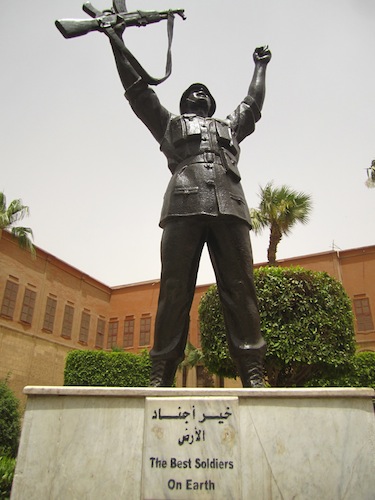
[Statue at the National Military Museum in Saladin Citadel, Cairo. Sign reads “The best soldiers on earth”. Image by Mohamed Elshahed]
The regime has a long record of manipulating historical narratives through the perpetuation of partial truths and forging images. The most notorious recent example entailed a doctored image showing then-President Mubarak walking in front of the American, Israeli, Jordanian and Palestinian heads-of-state at a peace summit convened in the White House on 1 September 2010. In reality, Mubarak was trailing the group. The editor of Al-Ahram, the state owned newspaper responsible for publishing this doctored photo, defended this overt deception as an attempt to highlight the “prominent stance of President Mubarak in the Palestinian issue, his unique role in leading it before Washington or any other.” For Mubarak, the past was and the present is whatever he and his airbrush artists wanted to make it, or in other words, a lie.
Mubarak’s architectural and visual legacy is a diluted and flimsy version of the work of dictators from a previous generation, when art and architecture were tools for social engineering. Mubarak’s regime relied on flat propaganda, a saturation of seemingly benign images of and songs about the president. Marble plaques bearing his name were placed on every official building, police stations, bus stations, museums, historic monuments, and even hotels are graced with Mubarak’s name, following an identical trend: “in the era of Mubarak…[such and such building] was erected/opened/restored.” Such buildings did not have to evoke greatness nor reflect a particular ideology in their form or aesthetic. The mere presence of the president’s name was enough to saturate daily life with the ever-present father, regardless of how miserable life was for the ordinary observers of these images. The omni-presence of an ageless Mubarak, often sporting designer sunglasses, created a cohesive reality in an otherwise disjointed urban setting. No matter where you stood, in the street, in the post office, or at work, you were in Mubarak country, in the reality he created.
.jpg)
[Marble plaque at Police National Museum documenting the presence of then-President Hosni Mubarak at the opening ceremony of the museum on 25 January 1986. Image by Mohamed Elshahed]
Mubarak had stiff competition in the tiny pantheon of Egyptian presidents. He was only third after Sadat and Nasser (Mohamed Naguib, Egypt’s first president, had been written out of history and his two-year rule never left behind an enduring mark). Nasser, however, with his charisma and skillful oration, his ability to reach out to the masses who embraced him—at least most of the time—has been a difficult act to follow. Sadat, although less charismatic, capitalized on the anti-Nasser sentiment built up following the 1967 defeat and presented himself as a wiser and a more prudent leader. Sadat too lived in an alternative reality created by his own will, but he strayed away from the kinds of populist displays as presidential father of the nation à la Nasser. For Mubarak, known to have been a lame duck, and an “accidental president,” the challenge to portray himself as father of the nation was not easy, but it was necessary. By the final decade of his rule, Mubarak was increasingly synonymous with Egypt, an embodiment of a nation. To be anti-Mubarak was to be anti-Egypt.
While Mubarak ruled by legal engineering, murdering and imprisoning members of the opposition, and selectively applying the law to target defectors from his circle of allies, in the public sphere he displayed a different image, pretending to be a loving father. Eventually, everyone around him became an actor in this theatrical play. The public too pretended to look up to the father figure barely smiling in billboard-sized portraits. Every politician, every businessman, and anyone else aspiring to move up the power ladder often extended lip service to Mubarak and congratulated him on his non-existent achievements. It was all theater, but it was so prevalent that it created a hyper-reality, in which everyone from the president to the populace seemed willing to play his or her assigned part.
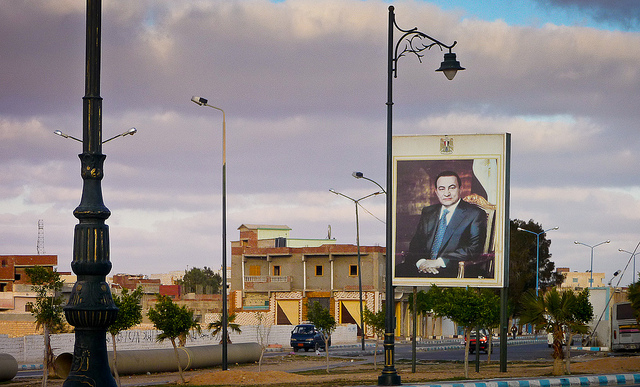
[A Mubarak billboard at the entrance of Marsa Matrouh. Image by brumd/Flickr.]
Mubarak’s propaganda was aimed at evoking the image of egalitarianism, presenting the president as a humble man of the people. His predecessors followed a similar approach. Sadat, for instance, was famously photographed shaving in his undershirt. Mubarak’s egalitarianism, however, was so far-fetched and unconvincing that it eventually turned into much more than just a simple lie. It became a fully conducted operatic performance with music, photography, and sometimes architecture, all relying on hyper-kitsch aiming to be accessible to the masses. It had to be visually accessible due to the prevalence of illiteracy in Egypt—one of the main factors on which Mubarak relied for the survival of his regime. Mubarak’s seeming egalitarianism, however, was far removed from reality, because he, and the ruling military class around him, exemplified longstanding colonial bourgeois values and were deeply entrenched in corrupt business networks. The so-called people’s president—who had in his reign acquired and created more official “palaces” than any of Egypt’s modern era rulers—was trying to seem in tune with a population of which sixty percent lives in informal unplanned areas.
Mubarak’s state-sponsored lies were manifested in painting and sculpture. The Abdeen Presidential Palace Museum displays gifts that were presented to successive Egyptian rulers over the course of the past two centuries. Among the displayed items is a painting that delivers a direct and unambiguous message that Mubarak is the best Egypt can offer and is the country’s savior. The painting portrays Mubarak standing among factories, workers, and agricultural laborers, with military jets overhead of course. Such images are not unusual in dictatorships. They bring to mind similar visual celebrations of Stalin or Egypt’s own Nasser. However, while such a medium had certain potency in 1930s Soviet Union or in 1960s Egypt (albeit to a lesser degree), such a painting of Mubarak done in the 1990s is rendered embarrassingly anachronistic by its visual language, message, and historical context.

[Mubarak painting in the Abdeen presidential palace. Image by Mohamed Elshaded.]
Outside the National Military Museum in Cairo’s Saladin Citadel, a similar image is manifest as a massive twenty-meter long metal relief sculpture. Again, the president is displayed overlooking the production of his subjects working gleefully. Such an image is not only a lie, but it also speaks to the gap between the regime’s self-image and reality. Workers and farmers, who are presented in a happy light by the sculpture, have in fact suffered the most during Mubarak’s tyrannical three-decade reign. These images, moreover, lack a clear sense of time. The observer is left wondering, is this Mubarak’s view of his past achievements, or is this his naïve vision for the future? The images certainly are disconnected from the present.
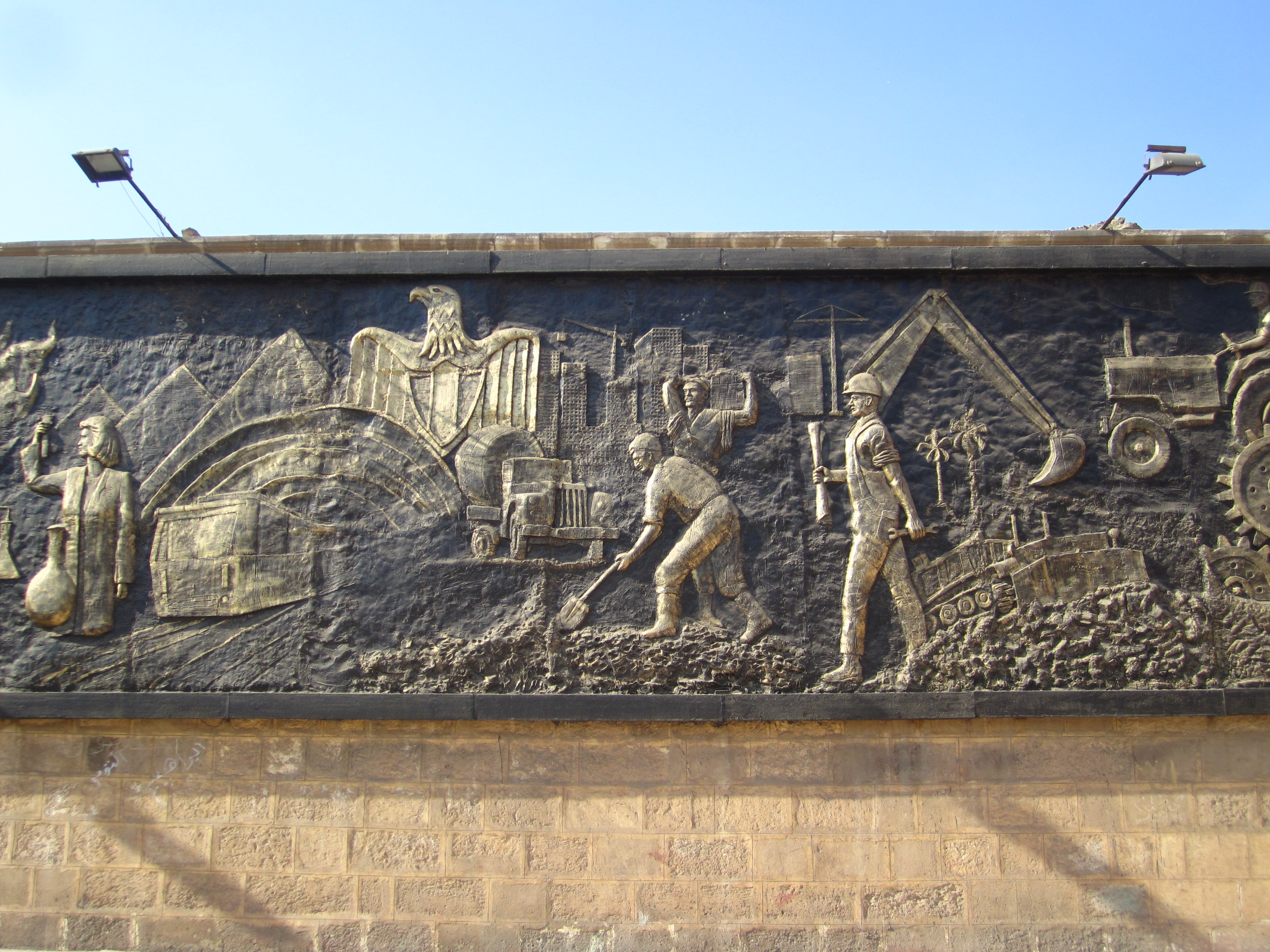
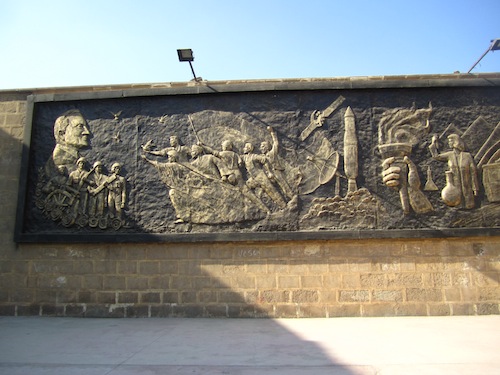
[Metal relief sculpture in Saladin Citadel, Cairo. Image by Mohamed Elshahed.]
The military jets overhead are a consistent motif meant to signify the president’s role in the army. Mubarak practiced absolute power for much of his thirty-year rule with the claim that it was his air strikes against Israeli forces that brought victory to the Egyptians in the 1973 War.
Reality is significantly altered, or completely airbrushed, not only in art, but also in history. History books carefully narrate the president’s role in planning and achieving “victory” in October 1973. The war and the regime’s narrative are memorialized in the Military Museum with large paintings and even a full-size sculpture showing Mubarak and Sadat among other generals standing over a table with a map. The sculpture is based on a photograph, which does not include Mubarak. A doctored version of this same photograph shows Mubarak as a mastermind standing with Sadat—only the two of them. This multiplicity of images, all purporting to document the same moment in history, is perhaps an indication that the moment represented never happened in reality.
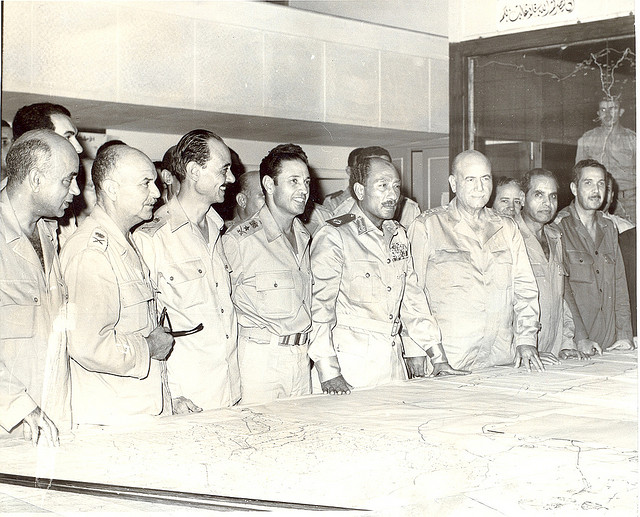
[The commandership of the 1973 October War. To the right of President Anwar Sadat is War Minister General Ahmed Ismail and to his left General Saad El-Din El-Shazaaly. Former President Hosni Mubarak is not visible. Image courtesy of Zeinab Mohamed.]
The 1973 war is also memorialized in its own “North Korean-style” propaganda that is the October 1973 War Panorama, a military museum commemorating Egypt’s “victory”. The museum provides a vividly clear insight into Mubarak’s alternative reality and airbrushed history. School children are often taken on fieldtrips to the museum in order to passively listen to the state’s official narrative of the war. The battles are illustrated with a panoramic diorama, complete with realist details, in an attempt to convince young minds that their real father is Mubarak, the man who delivered to Egyptians the 1973 victory. School children were inculcated with the notion that no matter how old they become, Mubarak will always be the father. In the military he was referred to as father. And after his supposed fall from power, a group was formed in his defense, not surprisingly called ”Mubarak’s children.”
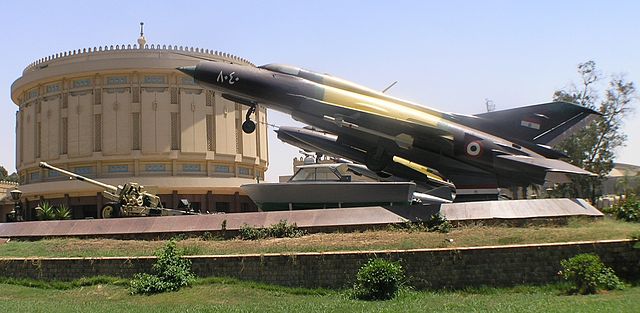
[1973 October War Panorama. Image by Daniel Mayer.]

[Poster from October 1973 War with a young Hosni Mubarak at the October War Panorama. Image by David Lisbona.]
The last military show of infantilism on the occasion of the Sixth of October was in 2010. As always, the production was aired live on state TV. Television was the only place to witness the spectacle, since Mubarak, being extremely paranoid about his own security, would never hold such a celebration in the presence of a large public audience, as did Hitler, Stalin or Kim Jong-iI. It is unsurprising, therefore, that such performances were highly insular and secured. After all, Mubarak’s predecessor Sadat was assassinated during a military celebration of the Sixth of October War in 1981. While the 2010 performance was aired on television, most Egyptians were still sleeping or watching another channel. The spectacle was further evidence that the ruler lived in a parallel universe completely disconnected from those he ruled.
The performance featured military men in uniform dancing and jumping around a small stage at the foot of the stands. The word “Egypt” appears to the right and the word “Mubarak” to the left of the stage. Other prancing dancers are dressed in kitschy costumes supposedly representing the populace, such as women in satin dresses blending together references to fellahin women and 1920s urban women who may have lived in one of Naguib Mahfouz’s novels. The dancers in actuality represent a reductive representation of an already reductive representation of folkloric characters from outdated 1960s nationalist myths. Time and place cease to exist: where is that supposedly folkloric Egyptian woman from and to what time period does she belong? Men in similarly ambiguous and invented costumes surround the women. It is unclear if the military uniforms dancing on stage are actual military men or actors portraying military men. The performance begs the question: Do Egyptians actually have a military, or merely the image of one?
In all these celebrations Field Marshal Mohamed Hussein Tantawi, who is today Egypt’s de facto president, was seated to the left of Mubarak. Tantawi, now single-handedly running Egypt, is a lame duck who came to power by accident, just like Mubarak. Tantawi is part of the Mubarak bubble, or the alternative reality that the deposed president and his regime were able to construct as a result of absolute power. While Mubarak and his men are, according to official statements, in prison, many believe that they comfortably living in a luxurious facility inside “Tora prison” or in the case of Mubarak himself, at a five-star hospital—all under the auspices of Tantawi and the ruling military council. It is perhaps more believable that the prison story is only farce, a continuation of the fabricated reality constantly projected to the public for decades.
Since assuming power over a year ago, Tantawi’s responses to crisis after crisis demonstrated nothing but the continuation of Mubarak’s political theater. For instance, in response to the 1 February massacre at a Port Said football match where seventy-three fans were killed, Tantawi proclaimed, “these things can happen in any country…we will pay the families of victims.” As for the victims of army and police violence over the past year, Tantawi offered medals. And to mark the first anniversary of the still unfinished revolution, which aims to undo the military’s grip on Egypt, which his leadership represents, Tantawi offered to hold a competition for constructing the best monument in Tahrir Square. In marking the Sixth of October in 2011, a massive telecommunication tower was erected, costing twenty million Egyptian pounds, only to place an Egyptian flag at its peak. At the flag raising event, army General Mohsen al- Fangary, famous for his paternal finger waving, reminded Egyptians that the “great Revolution of 2011” would not have been possible without the epic victory of 1973. His comments evoked the cynicism and performance that marked the Mubarak era. Hundreds of lives lost, thousands injured, and many more missing or forever affected by regime-sponsored brutality, and all this is supposed to be commemorated by a hollow monument and a meaningless iron tower with a flag at its top.
Beyond celebrations of fictive victories, events that purport to be real, such as the Mubarak trial, are also the result of careful orchestration of images, bits of information and state-constructed narratives. Images of bedridden Mubarak were aired on state television repeatedly in the early days of the trial: Mubarak wheeled out of an ambulance, Mubarak wheeled into an ambulance, or Mubarak in hospital bed in the iron cage of justice. These were images were poised to convey one simple message to the public: you won. Just as Mubarak was “removed” to preserve the regime and its interests, images of a helpless Mubarak were necessary to give the appearance that justice is taking its course and also to build sympathy for the “poor old man.” The theatrical nature of the trial was hardly discussed in the media as everyone seemed content to believe it was actually happening.

[Billboard at military museum reads: "The army and the people are one hand united. Image by Mohamed Elshaded.]
The regime’s continued manipulation of images and reality was most recently reflected in a poster that has been featured throughout the streets of Cairo showing of a man in uniform carrying a giant toddler. The poster started appearing first on armored vehicles, such as those protecting the U.S. Embassy, and later on billboards across the city. The text on the image is quite revealing: “al-gaish wal sha‘b yad waheda,” or the army and the people are one hand united. The text and the image together suggest that “the army” is visually represented as the man in uniform, while “the people” are inevitably the giant toddler. While paying homage to classic paternalistic images used by authoritarian military regimes as the protectors of the very people they oppress, the poster’s creators have recycled the oldest of colonial modes of representation: the colonized as child. Until the next president assumes office—presumably with the blessing of the SCAF—Egyptians are reminded that they are still children in the care of the Unknown Soldier until their “father” president returns. The poster further suggests the army generals in charge are not willing to do away with the authority they granted themselves to single handedly determine the destiny of Egyptians. Fortunately, the critical eye is capable of viewing images in ways that subvert its creator’s message. For this pedestrian the latest poster shows an army impostor kidnapping a toddler, in which case SCAF generals are represented by the man in uniform and the toddler represents Egypt`s young revolution.